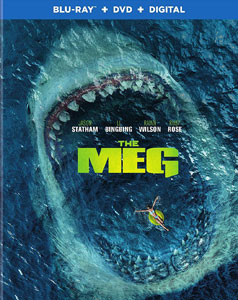I remembered Steve Alten’s 1997 novel “Meg: A Novel of Deep Terror” as being not particularly biting. But that doesn’t mean a fun big-budget movie couldn’t be made from it, as finally happened in 2018, a time when special effects could do justice to a massive prehistoric shark roaming the South Pacific.
Jonas and the whale … erm, shark
Retitled “The Meg,” director Jon Turteltaub’s film tonally falls somewhere between scary and silly. Scares are undercut with a quippy comic-relief character who also happens to be a top-shelf technician (Page Kennedy as DJ). Goofiness is softened with tense music or mildly intriguing pseudo-science.
Not that Jason Statham is bad as Jonas, an underwater rescue specialist who comes over – at least in name – from Alten’s book. But when Jonas smirks and snaps out quips in his tough-guy brogue, you know this isn’t too serious of a film.

“The Meg” (2018)
Director: Jon Turteltaub
Writers: Dean Georgaris, Jon Hoeber, Erich Hoeber (screenplay); Steve Alten (novel)
Stars: Jason Statham, Bingbing Li, Rainn Wilson
On Tuesdays this summer, Reviews from My Couch is highlighting classic (and not so classic) shark horror films through the years.
Further diversions come from Jonas’ various issues: He still cares about ex-wife Lori (Jessica McNamee), a thread comparable – but not in “The Meg’s” favor – to “The Abyss.” Jonas forms a new bond with Suyin (Li Bingbing) in an out-of-nowhere scene where she’s impressed by him in a towel. The trio of screenwriters throw in Suyin’s cute kid (Sophia Cai as Meiying) to dare viewers to criticize the story’s human aspects.
High-seas adventure
Initially, “The Meg” is (or pretends to be) sober science fiction. We start in “Deep Blue Sea” fashion at a cutting-edge facility – funded by Rainn Wilson instead of Samuel L. Jackson – that studies the deep in ungoverned waters for the sake of corporate profits. (The area is so ungoverned that if Jonas beats up the doctor he loathes, Robert Taylor’s Heller, he’ll face no legal repercussions.)
This is Jules Vernean sci-fi, though. In reality, a thermocline is the level at which ocean water changes suddenly in temperature. In “The Meg,” it’s a firm dividing line. Our explorers don’t even know if the thermocline is penetrable.
Once they do penetrate it, they don’t know what’s down there. But we do, because of the movie’s title: a Carcharodon megalodon, which lived from 25 to 1.5 million years ago.
What about the regular sharks?
Now we’re off on a grand adventure, and Turteltaub (“National Treasure”) knows how to shoot and pace this stuff. As the group attempts to track and catch the megalodon, Jonas and Suyin are connected to a boat by a cable. The parallel to bait on a hook is probably not accidental, but it’s hard to say for sure with “The Meg.” It’s too slick and competent to be labeled “dumb,” but it does have some logical oddities.

For one, the bigness of the shark makes it more awe-inspiring than regular-sized sharks – but it shouldn’t make it so much scarier that other oceanic threats cease to matter.
The characters aren’t worried about regular-sized sharks, even though they see several of them while tracking the megalodon – and even though I’ve seen movies based on real events where regular sharks eat people stranded in the ocean (such as “The Reef”).
Indeed, one could argue that a run-of-the-mill great white would be more likely than a meg to notice and eat a human.
Not an ordinary day at the beach
These things keep “The Meg” from being serious sci-fi. But for spectacle, “The Meg” doesn’t skimp. For the grand finale, we get a supremely colorful beach scene that puts the “Jaws” sequence on steroids. Hundreds of revelers pepper the waters off a resort island. The innertubes of various colors look like Life Savers candy in the overhead shot. If I was a meg, my appetite would be stoked too.
If any of the vacationers’ lives are spared, it’ll be because it’s logistically challenging for a mega-shark to sweep them all up. It’d be like picking up the last grains of rice with a fork. And while there’s no denying the meg likes Chinese food, these humans are snacks compared to a delicious whale. So Sunyin uses recorded whale calls to draw it away.
Throughout “The Meg,” the premise is insane but the strategies in the moment by our protagonists aren’t. The people aren’t particularly developed, so we don’t care too much when they are eaten – and I never sense that Suyin or Jonas will be among the victims anyway. The threat of the meg is massive, but also rather empty.
But it’s all in good fun, so we don’t have to slap ourselves in the face for watching “The Meg,” nor for being interested in next year’s sequel (also based on an Alten novel), “Meg 2: The Trench.”

